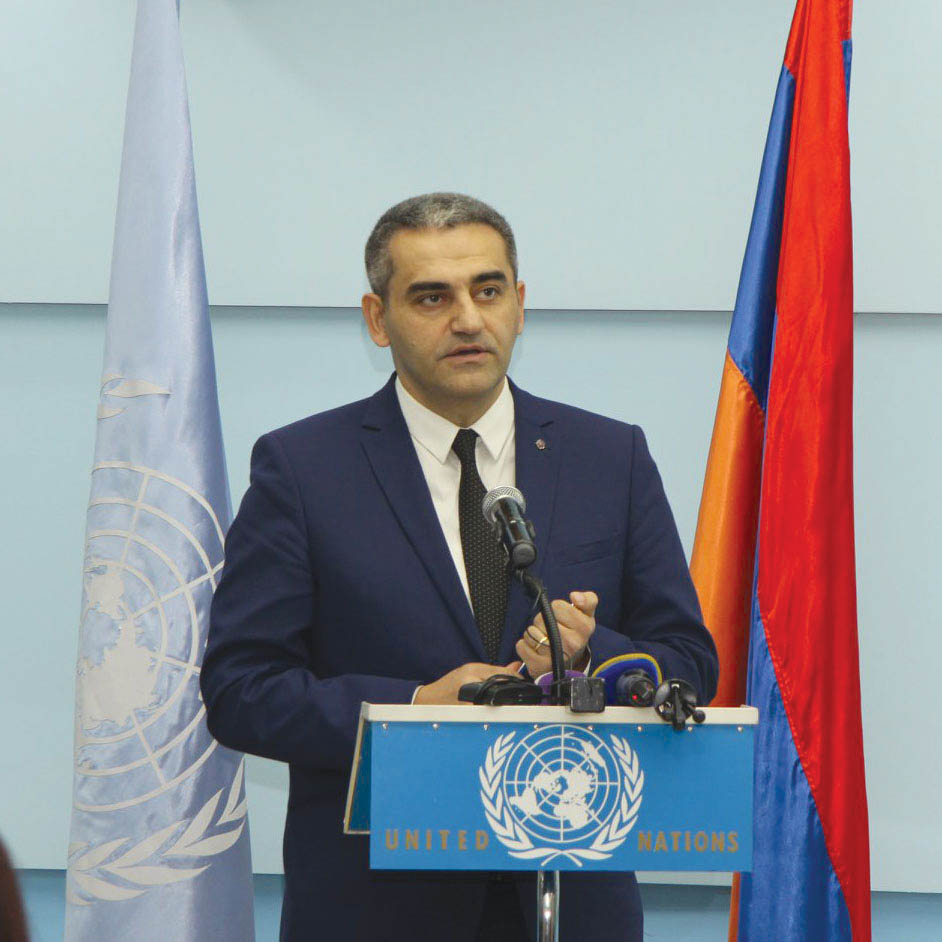
Photo: ASP Archive
Christine Pambukyan
Staff Writer
“We should remember that genocide is, first of all, a man-made event, and genocide is something that people initiate. These are human beings who kill human beings,” emphasized Dr. Suren Manukyan, Kazan Visiting Professor of Armenian Studies in Fall 2021 and head of the UNESCO chair on the Prevention of Genocide and other Atrocity Crimes at Yerevan State University in Armenia.
On Friday, November 12, 2021, Dr. Manukyan concluded his three-part lecture series on “The Perpetrators of the Armenian Genocide,” with a discussion about the ordinary murderers who participated in the 1915 massacres and Genocide in an online lecture titled, “The Ordinary Killers of Armenian Genocide: The Lower-Level Perpetrators.” His lecture demonstrated how the implementation of genocide is impossible without the mass participation of society.
Armenian Studies Program Berberian Coordinator Prof. Barlow Der Mugrdechian welcomed the audience and introduced Dr. Manukyan.
After thanking the viewers and the Armenian Studies Program for the opportunity to share his research findings, Dr. Manukyan began his lecture by explaining a flow chart about the hierarchy of perpetrators of genocide: 1) the decision makers, such as the government, ruling party, and ideologues who initiate genocide; 2) the bureaucracy, such as local bureaucrats and party secretaries that facilitate genocide; and 3) the shooters, such as the special forces created for extermination or the ordinary people who carry out acts of genocide or crimes against humanity.
The ordinary killers are those “who participated in the killings, or the process of the implementation of genocide; taking advantage of the atmosphere of impunity, entertaining general popular support. The usage of non-regular forces to carry out the dirty job was a tried and true Ottoman tradition,” stated Dr. Manukyan.
“A semi-military structure, Teşkilat-i Mahsusa, also known as the “Special Organization,” had a pivotal role in the Armenian Genocide. Its eastern branch, responsible for organizing Armenian deportations and massacres, was headed by Behaeddin Shakir.
Manpower to commit the atrocities was replenished with criminals set free from prisons,” explained Dr. Manukyan, when discussing the sporadic and irregular forces that had a key role in the Armenian Genocide I. These forces, which operated under the leadership of Minister of War Enver Pasha, were influenced by Pan-Turkism and Pan-Islamism.
Throughout its history, the “Special Organization” had three Circassian leaders: Ali Bashkamba, Husamedin Erturk, and Suleyman Askeri, who worked under the head of the organization, Behaeddin Sakir. “As early as 1914, Behaeddin Sakir traveled to Erzerum with another Circassian, Hussein Husni, with the purpose of forming armed groups in Armenian provinces and later he would coordinate the activities of the Special Organization by touring by automobile to the regions and well as by means of telegrams,” added Dr. Manukyan.
The “Special organization” had four goals, including organizing the disarmament of the Armenian population, organizing detachments which would carry out the deportation and extermination of the Armenian population, organizing detachments for the extermination of the Armenians within the deserts of Syria and concentration camps, and the supervision and coordination of civilian authorities within the provinces in the organization of the Armenian Genocide.
The individuals that made up the groups that were sent to implement the plans of genocide included Kurdish tribes, immigrants from the Caucasus and Balkans, and criminals released from prisons. These were also instrumental in the earlier 1895-1896 Hamidian massacres.
“We don’t see such examples in other genocides. Criminals, people who were sentenced to some time of imprisonment, were released. They were set free from prisons to organize [and] participate in committing genocide,” said Dr. Manukyan. These groups were known as criminals by all, including the Turkish officials, due to their horrendous role in the Genocide. The role of the Balkan immigrants in the Genocide was guided by their feeling of revenge against Armenians and their hatred of Christians, even though the Armenians did not have a role in the persecutions they had to endure.
According to Dr. Manukyan, the Kurdish and Turkish involvement had the most impact on the Armenian Genocide. The Kurds participated in taking the villages and farms of the Armenian people, as they were aspiring to gain their land and their wealth.
Dr. Manukyan concluded his lecture by discussing the role of propaganda in the implementation of Armenian Genocide. To achieve the approval of the masses, “the authorities relied on the spreading of rumors, instigating talks of imminent danger, reactivating deep and subconscious superstition, and exploiting other means to help justify the crime and to shift the responsibility from the true perpetrators to the objectified, frenzied mass of people,” stated Dr. Manukyan.
Due to the propaganda, participation in the Genocide included not only men, but also women, similar to German participation in the Holocaust. Unlike other genocides, however, every Armenian was harmed and killed no matter if they were young or old, man, woman, or child. Excessive propaganda is an important precondition of war and new leadership, leading to an “Us vs. Them” situation.
At the end of the discussion, viewers were able to ask Dr. Manukyan and Prof. Der Mugrdechian questions through the chat function on Zoom.
A recording of the discussion, along with other lectures of this semester, can be found on the Armenian Studies YouTube Channel at https://bit.ly/armenianstudiesyoutube.
 Hye Sharzhoom Armenian Action
Hye Sharzhoom Armenian Action